PEUGEOT 5008 2016 Owners Manual
Manufacturer: PEUGEOT, Model Year: 2016, Model line: 5008, Model: PEUGEOT 5008 2016Pages: 364, PDF Size: 12.98 MB
Page 191 of 364
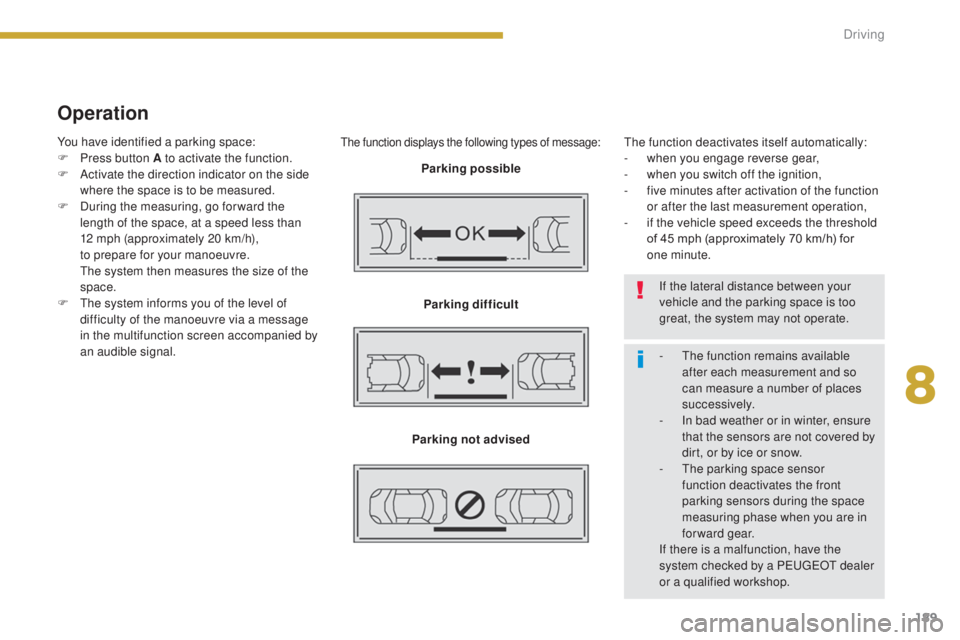
189
5008_en_Chap08_conduite_ed01-2015
Operation
The function displays the following types of message:
Parking possibleParking difficult
Parking not advised The function deactivates itself automatically:
- w
hen you engage reverse gear,
- w hen you switch off the ignition,
-
f
ive minutes after activation of the function
or after the last measurement operation,
-
i
f the vehicle speed exceeds the threshold
of 45 mph (approximately 70 km/h) for
one
minute.
If the lateral distance between your
vehicle and the parking space is too
great, the system may not operate.
-
T
he function remains available
after each measurement and so
can measure a number of places
su c c e s s i ve l y.
-
I
n bad weather or in winter, ensure
that the sensors are not covered by
dirt, or by ice or snow.
-
T
he parking space sensor
function deactivates the front
parking sensors during the space
measuring phase when you are in
forward gear.
If there is a malfunction, have the
system checked by a PEUGEOT dealer
or a qualified workshop.
You have identified a parking space:
F
P
ress button A to activate the function.
F
A
ctivate the direction indicator on the side
where the space is to be measured.
F
D
uring the measuring, go for ward the
length of the space, at a speed less than
12
mph (approximately 20 km/h),
to prepare for your manoeuvre.
T
he system then measures the size of the
space.
F
T
he system informs you of the level of
difficulty of the manoeuvre via a message
in the multifunction screen accompanied by
an audible signal.
8
Driving
Page 192 of 364
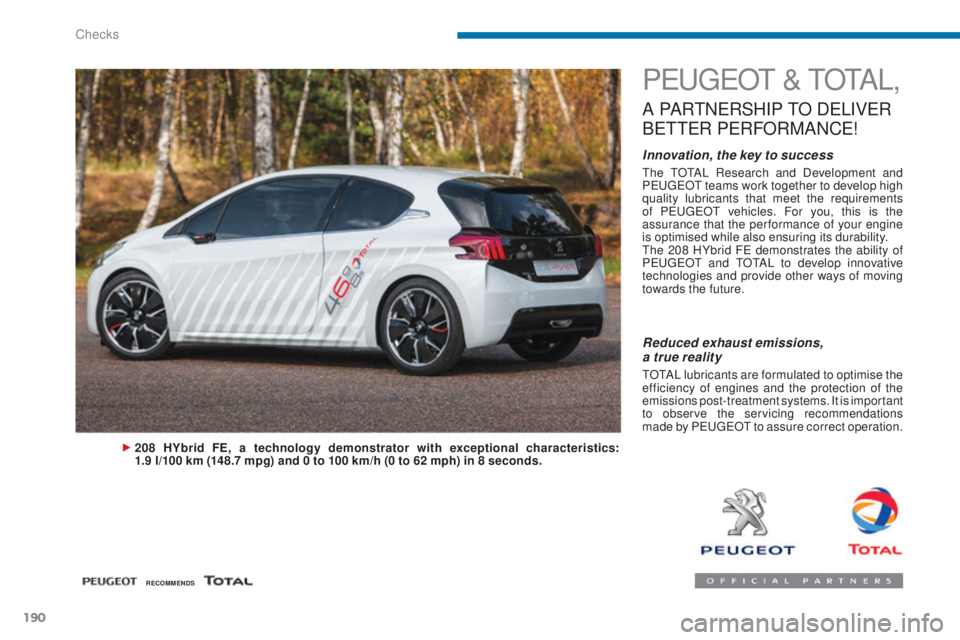
190
5008_en_Chap09_verifications_ed01-2015
PEUGEOT & TOTAL,
A PARTNERSHIP TO DELIVER
B
ETTER
PERFORMANCE
!
Innovation, the key to success
The TOTAL Research and Development and
PEUGEOT teams work together to develop high
quality lubricants that meet the requirements
of PEUGEOT vehicles. For you, this is the
assurance that the performance of your engine
is optimised while also ensuring its durability.
The 208 HYbrid FE demonstrates the ability of
PEUGEOT and TOTAL to develop innovative
technologies and provide other ways of moving
towards the future.
208 HYbrid FE, a technology demonstrator with exceptional characteristics:
1.9 l/100 km (148.7 mpg) and 0 to 100 km/h (0 to 62 mph) in 8 seconds.
Reduced exhaust emissions,
a true reality
TOTAL lubricants are formulated to optimise the
efficiency of engines and the protection of the
emissions post-treatment systems. It is important
to observe the servicing recommendations
made by PEUGEOT to assure correct operation.
RECOMMENDS
Checks
Page 193 of 364
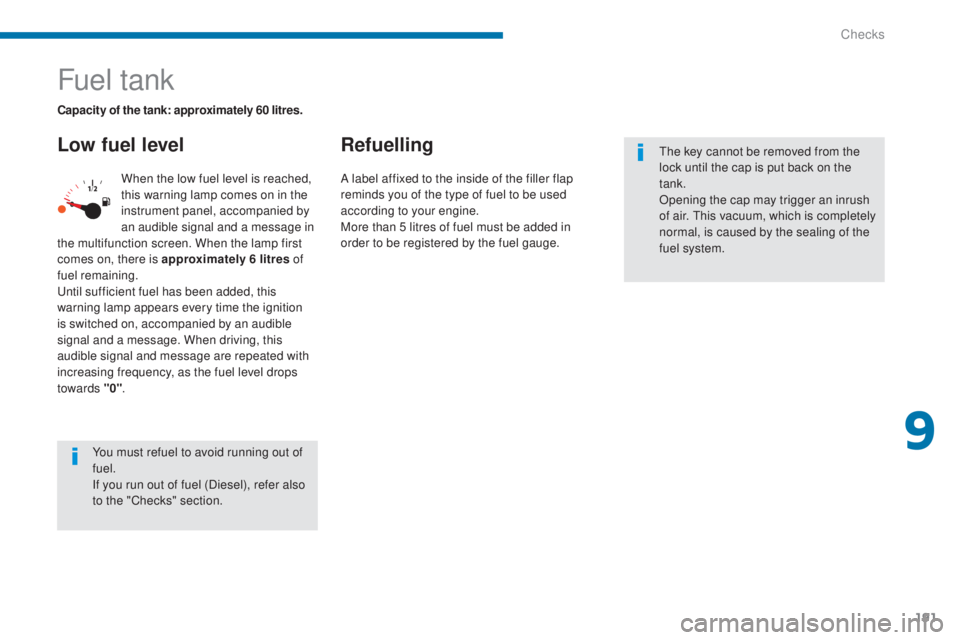
191
5008_en_Chap09_verifications_ed01-2015
Fuel tank
Low fuel levelRefuelling
When the low fuel level is reached,
this warning lamp comes on in the
instrument panel, accompanied by
an audible signal and a message in
the multifunction screen. When the lamp first
comes on, there is approximately 6 litres of
fuel remaining.
Until sufficient fuel has been added, this
warning lamp appears every time the ignition
is switched on, accompanied by an audible
signal and a message. When driving, this
audible signal and message are repeated with
increasing frequency, as the fuel level drops
towards "0" .
Capacity of the tank: approximately 60 litres.
The key cannot be removed from the
lock until the cap is put back on the
tank.
Opening the cap may trigger an inrush
of air. This vacuum, which is completely
normal, is caused by the sealing of the
fuel system.
You must refuel to avoid running out of
fuel.
If you run out of fuel (Diesel), refer also
to the "Checks" section. A label affixed to the inside of the filler flap
reminds you of the type of fuel to be used
according to your engine.
More than 5 litres of fuel must be added in
order to be registered by the fuel gauge.
9
Checks
Page 194 of 364
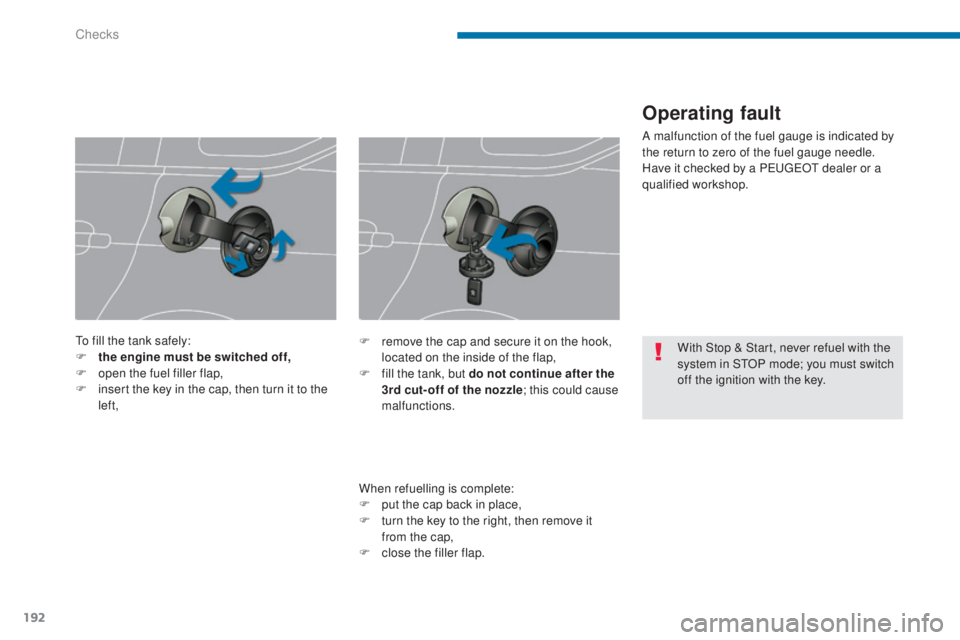
192
5008_en_Chap09_verifications_ed01-2015
With Stop & Start, never refuel with the
system in STOP mode; you must switch
off the ignition with the key.
To fill the tank safely:
F
t
he engine must be switched off,
F
o
pen the fuel filler flap,
F
i
nsert the key in the cap, then turn it to the
left,
When refuelling is complete:
F
p
ut the cap back in place,
F
t
urn the key to the right, then remove it
from the cap,
F
c
lose the filler flap.
F
r
emove the cap and secure it on the hook,
located on the inside of the flap,
F
f
ill the tank, but do not continue after the
3rd cut- off of the nozzle ; this could cause
malfunctions.
Operating fault
A malfunction of the fuel gauge is indicated by
the return to zero of the fuel gauge needle.
Have it checked by a PEUGEOT
dealer or a
qualified workshop.
Checks
Page 195 of 364
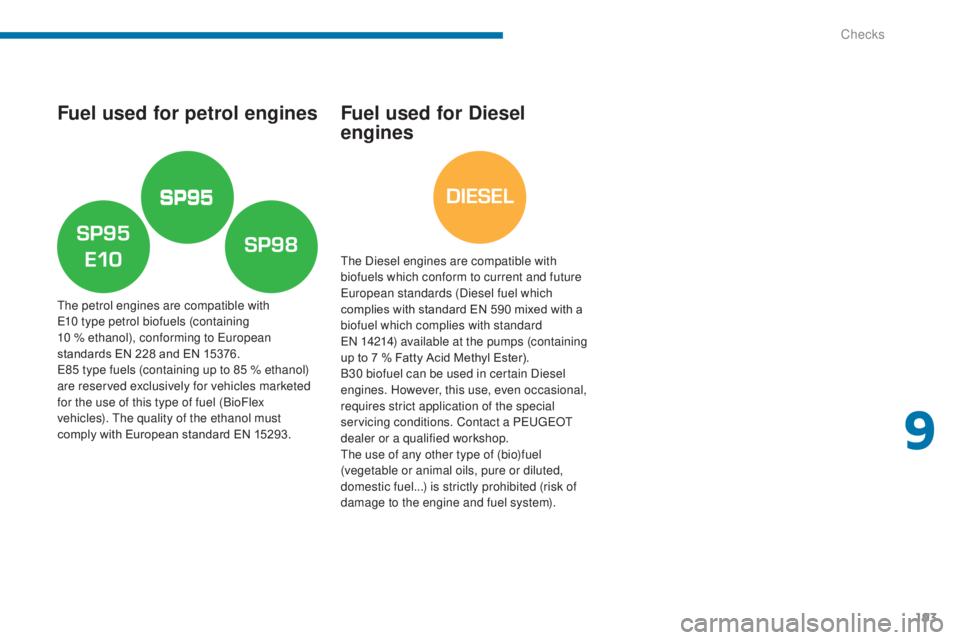
DIESEL
193
5008_en_Chap09_verifications_ed01-2015
Fuel used for petrol engines
The petrol engines are compatible with
E10 type petrol biofuels (containing
10 % ethanol), conforming to European
standards EN 228 and EN 15376.
E85 type fuels (containing up to 85 % ethanol)
are reserved exclusively for vehicles marketed
for the use of this type of fuel (BioFlex
vehicles). The quality of the ethanol must
comply with European standard EN 15293.
Fuel used for Diesel
engines
The Diesel engines are compatible with
biofuels which conform to current and future
European standards (Diesel fuel which
complies with standard EN 590 mixed with a
biofuel which complies with standard
EN 14214) available at the pumps (containing
up to 7 % Fatty Acid Methyl Ester).
B30 biofuel can be used in certain Diesel
engines. However, this use, even occasional,
requires strict application of the special
servicing conditions. Contact a PEUGEOT
dealer or a qualified workshop.
The use of any other type of (bio)fuel
(vegetable or animal oils, pure or diluted,
domestic fuel...) is strictly prohibited (risk of
damage to the engine and fuel system).
9
Checks
Page 196 of 364
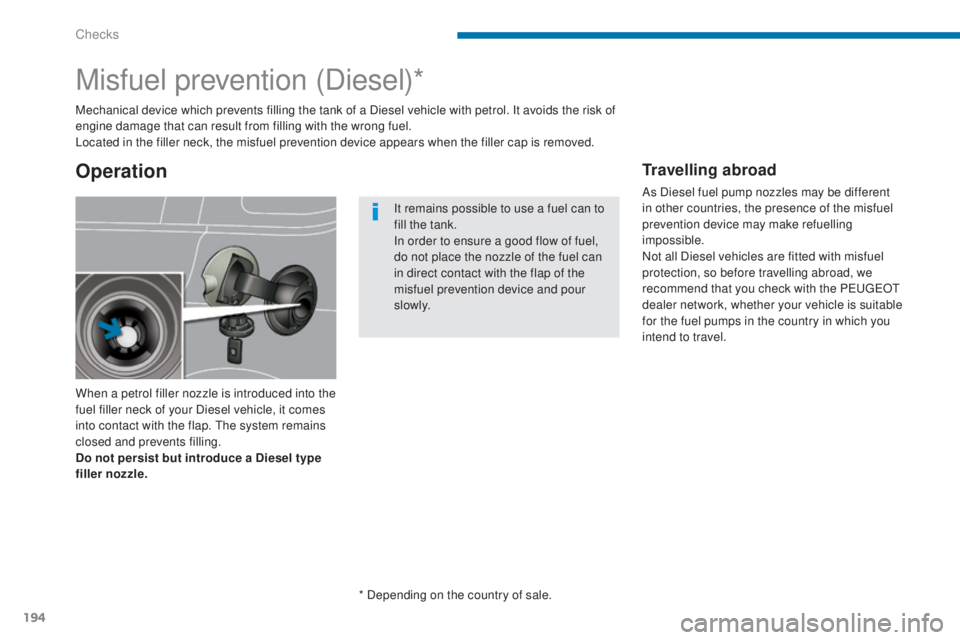
194
5008_en_Chap09_verifications_ed01-2015
Misfuel prevention (Diesel)*
When a petrol filler nozzle is introduced into the
fuel filler neck of your Diesel vehicle, it comes
into contact with the flap. The system remains
closed and prevents filling.
Do not persist but introduce a Diesel type
filler nozzle. Mechanical device which prevents filling the tank of a Diesel vehicle with petrol. It avoids the risk of
engine damage that can result from filling with the wrong fuel.
Located in the filler neck, the misfuel prevention device appears when the filler cap is removed.
Operation
It remains possible to use a fuel can to
fill the tank.
In order to ensure a good flow of fuel,
do not place the nozzle of the fuel can
in direct contact with the flap of the
misfuel prevention device and pour
s l ow l y.
Travelling abroad
As Diesel fuel pump nozzles may be different
in other countries, the presence of the misfuel
prevention device may make refuelling
impossible.
Not all Diesel vehicles are fitted with misfuel
protection, so before travelling abroad, we
recommend that you check with the PEUGEOT
dealer network, whether your vehicle is suitable
for the fuel pumps in the country in which you
intend to travel.
* Depending on the country of sale.
Checks
Page 197 of 364

195
5008_en_Chap09_verifications_ed01-2015
Running out of fuel (Diesel)
Other engines
F Add at least five litres of Diesel fuel to the tank.
F
O
pen the bonnet.
F
I
f necessary, unclip the styling cover for
access to the priming pump.
F
S
queeze and release the priming pump
repeatedly until resistance is felt (there
may be resistance at the first press).
F
O
perate the starter to start the engine
(if the engine does not start at the first
attempt, wait around 15 seconds before
trying again).
F
I
f the engine does not start after a few
attempts, operate the priming pump again
then start the engine.
F
R
efit the styling cover and clip it in place.
F
C
lose the bonnet.
On vehicles fitted with Diesel engines, the fuel
system must be primed if you run out of fuel.
For all versions other than BlueHDi, refer to the
corresponding engine compartment view.
If the engine does not start first time,
don't keep trying but start the procedure
again from the beginning.
BlueHDi engines
F Fill the fuel tank with at least five litres of Diesel.
F
S
witch on the ignition (without starting the
engine).
F
W
ait around 6 seconds and switch off the
ignition.
F
R
epeat the operation 10 times.
F
O
perate the starter to run the engine.
For more information on the Diesel
misfuel prevention device, refer to the
corresponding section.
9
Checks
Page 198 of 364
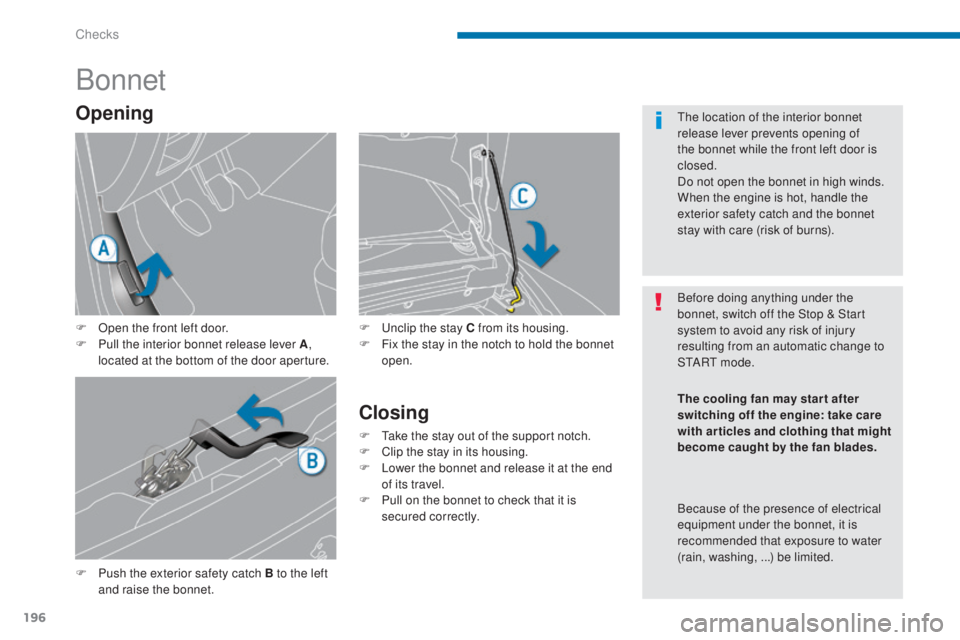
196
5008_en_Chap09_verifications_ed01-2015
Bonnet
F Push the exterior safety catch B to the left and raise the bonnet. F
U
nclip the stay C from its housing.
F
F
ix the stay in the notch to hold the bonnet
open.
Closing
F Take the stay out of the support notch.
F C lip the stay in its housing.
F
L
ower the bonnet and release it at the end
of its travel.
F
P
ull on the bonnet to check that it is
secured correctly.
Opening
F Open the front left door.
F P ull the interior bonnet release lever A ,
located at the bottom of the door aperture. Before doing anything under the
bonnet, switch off the Stop & Start
system to avoid any risk of injury
resulting from an automatic change to
S TA R T m o d e . The location of the interior bonnet
release lever prevents opening of
the bonnet while the front left door is
closed.
Do not open the bonnet in high winds.
When the engine is hot, handle the
exterior safety catch and the bonnet
stay with care (risk of burns).
The cooling fan may star t after
switching off the engine: take care
with articles and clothing that might
become caught by the fan blades.
Because of the presence of electrical
equipment under the bonnet, it is
recommended that exposure to water
(rain, washing, ...) be limited.
Checks
Page 199 of 364
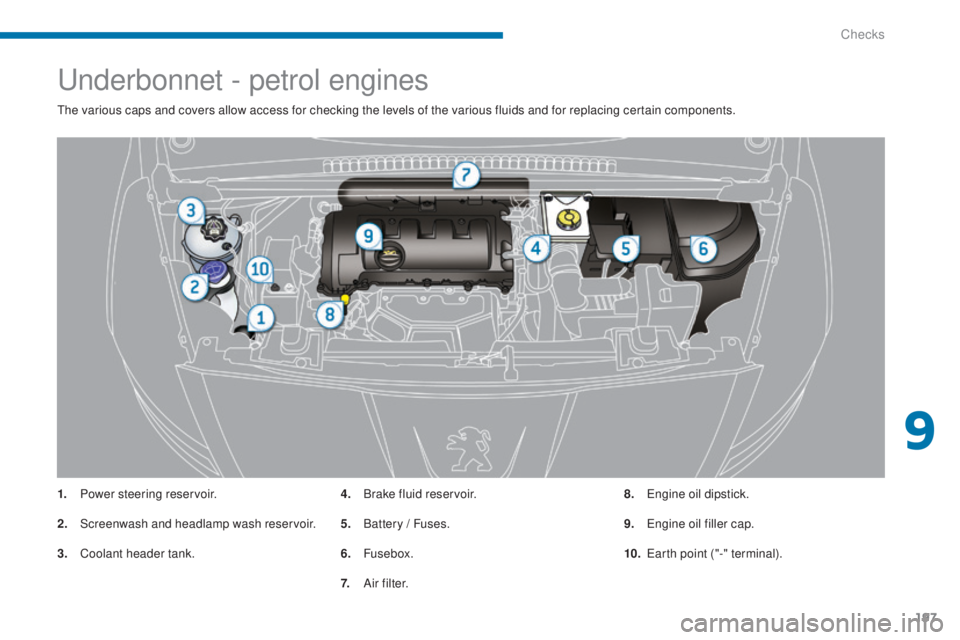
197
5008_en_Chap09_verifications_ed01-2015
Underbonnet - petrol engines
The various caps and covers allow access for checking the levels of the various fluids and for replacing certain components.
1.
P
ower steering reservoir.
2.
S
creenwash and headlamp wash reservoir.
3.
C
oolant header tank. 4.
B
rake fluid reservoir.
5.
B
attery / Fuses.
6.
Fusebox.
7.
A
i r f i l t e r.8.
E
ngine oil dipstick.
9.
E
ngine oil filler cap.
10.
E
arth point ("-" terminal).
9
Checks
Page 200 of 364
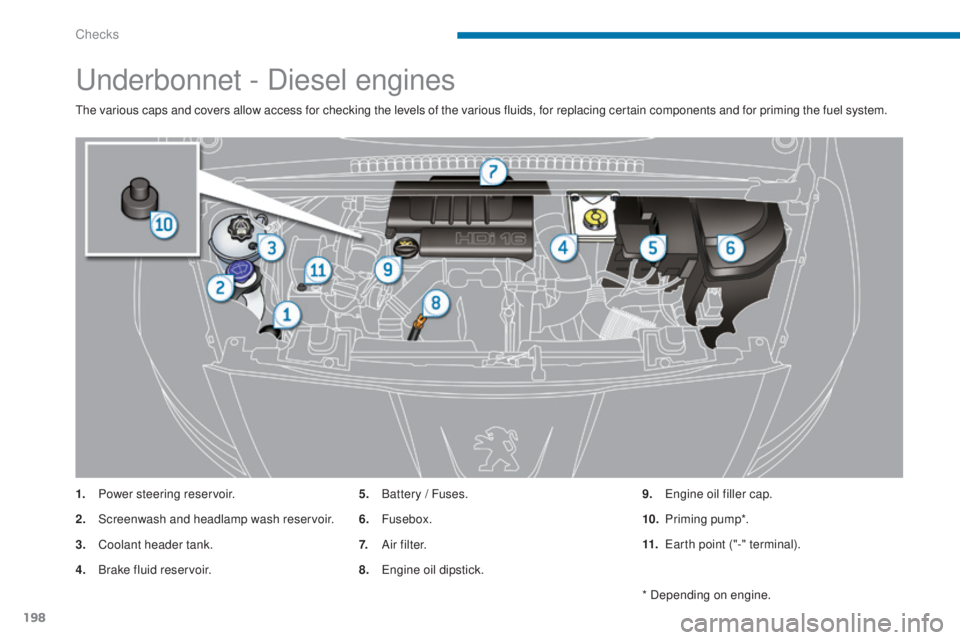
198
5008_en_Chap09_verifications_ed01-2015
Underbonnet - Diesel engines
The various caps and covers allow access for checking the levels of the various fluids, for replacing certain components and for priming the fuel system.
1.
P
ower steering reservoir.
2.
S
creenwash and headlamp wash reservoir.
3.
C
oolant header tank.
4.
B
rake fluid reservoir. 5.
B
attery / Fuses.
6.
Fusebox.
7.
A
i r f i l t e r.
8.
E
ngine oil dipstick.9.
E
ngine oil filler cap.
10.
P
riming pump*.
11.
E
arth point ("-" terminal).
* Depending on engine.
Checks